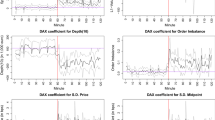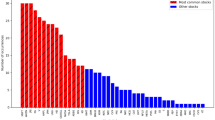Abstract
Simultaneous trading of multiple assets is becoming more common in financial markets, but financial analysts argue that it may bring unintended consequences, such as an increase in volatility. Agent-based simulations are useful ways to study market dynamics and acquire information to devise market rules. In this study, we constructed a multi-asset artificial market model and investigated the effect of arbitrage trading among multiple assets on price shock transfer from one asset to the whole market. The model is composed of two sorts of asset: index futures and its underlying stocks (the components of the market index). Our simulation featured two types of agent: local traders and arbitrageurs. A local trader sells or buys a single asset. Arbitrageurs can profit from a price difference between the index futures and the underlying stocks by applying the rule: buy cheap ones and sell expensive ones simultaneously. From exhaustive simulations of various trading strategies of local traders, we found that a shock transfer can be initiated and accelerated by local traders with certain strategies and arbitrageurs. Furthermore, we investigated how arbitrageurs and a market regulation, i.e., trading halt, work together. We found some situations in which trading halts increase market volatility. The implications for market regulations are discussed.









Similar content being viewed by others
Notes
The divergence \(\ln (p^{s*}_t / p^{s}_t)\) can be interpreted as the velocity (the magnitude and direction) of price \(p^{s*}_t\) moving toward its mean, which is the initial price because we set the drift term \(\mu ^{s*}_t\) to 0. Accordingly, \(1 / \tau ^{s*}\) determines the time at which the price \(p^{s*}_t\) is expected to revert to its mean.
An exchange-traded fund (ETF) is a security that tracks an index and trades like a single stock on an exchange. In this study, we omit the influences of interest rates, so the index futures are almost the same as an ETF.
References
Abad D, Pascual R (2013) Holding back volatility: circuit breakers, price limits, and trading halts. In: Baker H, Kiymaz H (eds) Market microstructure in emerging and developed markets, Wiley, chap 17
Ben-David I, Franzoni F, Moussawi R (2014) Do ETFs increase volatility? Working Paper 20071, The National Bureau of Economic Research
Chiarella C, Iori G (2002) A simulation analysis of the microstructure of double auction markets. Quant Finance 2:346–353
Chiarella C, Dieci R, He X (2007) Heterogeneous expectations and speculative behavior in a dynamic multi-asset framework. J Econ Behav Organ 62(3):408–427
Chiarella C, Iori G, Perello J (2009) The impact of heterogeneous trading rules on the limit order book and order flows. J Econ Dyn Control 33(3):525–537
Darley V, Outkin AV (2007) A NASDAQ market simulation: insights on a major market from the science of complex adaptive systems. World Scientific
Grudzinski C (2012) ETF arbitrage may be driving market volatility. The street. http://www.thestreet.com/story/11644440/1/etf-arbitrage-may-be-driving-marketvolatility.html
Harmon D, de Aguiar MAM, Chinellato DD, Braha D, Epstein IR, Bar-Yam Y (2010) Predicting economic market crises using measures of collective panic. Tech. rep, New England Complex Systems Institute
Hommes CH (2001) Financial markets as nonlinear adaptive evolutionary systems. Quant Finance 1:149–167
Izumi K, Matsui H, Matsuo Y (2007) Socially embedded multi-agent based simulation of financial market. In: Proceedings of the 6th international joint conference on autonomous agents and multi-agent systems (AAMAS 07), pp 1103–1105
Kawakubo S, Izumi K, Yoshimura S (2014) Analysis of an option market dynamics based on a heterogeneous agent model. Intell Syst Acc Finance Manag 21(2):105–128
Kodia Z, Said LB, Ghedira K (2009) SiSMar: social multi-agent based simulation of stock market. In: Proceedings of the 8th international joint conference on autonomous agents and multi-agent systems (AAMAS 09), pp 1345–1346
Leitner S, Wall F (2013) Artificial economics and self organization: agent-based approaches to economics and social systems. Springer
Lux T, Marchesi M (2000) Volatility clustering in financial markets : a microsimulation of interacting agents. Int J Theor Appl Finance 3:675–702
Ma CK, Rao RP, Sears RS (1989) Volatility, price resolution, and the effectiveness of price limits. J Financial Serv Res 3:165–199
Mandelbrot B (1963) The variation of certain speculative prices. J Bus 36(4):394–419
Mizuta T, Hayakawa S, Izumi K, Yoshimura S (2013) Simulation study on effects of tick size difference in stock markets competition. In: Proceedings of the 8th international workshop on agent-based approach in economic and social complex systems (AESCS2013), pp 235–246
Mizuta T, Noritake Y, Hayakawa S, Izumi K (2015) Impacts of speed-up of market system on price formations using artificial market simulations. Working Paper 9, Japan Exchange Group (JPX)
Murase Y, Uchitane T, Ito N (2014) A tool for parameter-space explorations. Phys Proc 57C:73–76
Senft E (2013) How many markets do you trade simultaneously? http://traderkingdom.com/trading-futures-education-topics/trading-futures-basics/2856-how-many-markets-do-you-trade-simultaneously
Sornette D (2002) Why stock markets crash: critical events in complex financial systems. Princeton University Press, Princeton
US Securities and Exchange Commission, the Commodity Futures Trading Commission (2010) Findings regarding the market events of May 6, 2010
Wah E, Wellman MP (2013) Latency arbitrage, market fragmentation, and efficiency: a two-market model. In: Proceedings of the 14th ACM conference on electronic commerce, pp 855–872
Westerhoff F (2003) Speculative markets and the effectiveness of price limits. J Econ Dyn Control 28:493–508
Westerhoff F (2004) Multiasset market dynamics. Macroecon Dyn 8(05):596–616
Xu HC, Zhang W, Xiong X, Zhou WX (2014) An agent-based computational model for china’s stock market and stock index futures market. Math Prob Eng 2014:563912
Acknowledgments
This work was supported by CREST, JST.
Author information
Authors and Affiliations
Corresponding author
About this article
Cite this article
Torii, T., Izumi, K. & Yamada, K. Shock transfer by arbitrage trading: analysis using multi-asset artificial market. Evolut Inst Econ Rev 12, 395–412 (2015). https://doi.org/10.1007/s40844-015-0024-z
Published:
Issue Date:
DOI: https://doi.org/10.1007/s40844-015-0024-z




